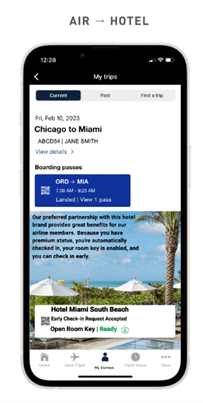Providing an optimal customer experience during travel has always been a challenging endeavor with unforeseen complications and disjointed customer journeys. I recently spoke with Angela Shannon, Director of Marketing at Journera, to learn more about the company’s focus and dig into the benefits of the TripSignals solution.
Disjointed Travel Journeys are a CX Pain Point
Journera was founded in 2016 by travel industry veterans with deep connections and expertise in the industry, including Jeff Katz the founding CEO of Orbitz Worldwide, former CEO of Swissair, and an executive at both SABRE and American Airlines.
Katz was interested in smoothing the traveler journey, which was an area that had been a bit neglected in the travel technology ecosystem and needed some improvement. Journera was formed to be focused on the customer journey and the benefits that could be brought to the traveler, as well as the brand, if the journey were improved. Customers would have a better experience, and travel brands would be ranked higher and have more loyal customers who potentially would increase spending.
Journera decided to bring the journey together by linking data and collaborating with key partners in the industry. The company has six founding partners that are amongst the world’s largest travel brands. United, American, Hilton, Hyatt, IHG, and Marriott Bonvoy signed on, and are committed to this idea of making a more seamless experience for the customer.
Journera provides the link, or secure data exchange, to improve the experience for a traveler who is moving among and between different brands. This data helps companies to see a customer journey in its entirety, and gives an opportunity to understand customer travel behavior and preferences beyond their own travel vertical.
“Each of Journera’s founding partners work closely with us, and all the permissions are completely in their control. Journera basically provides privacy-compliant “smart plumbing” for these partners to share only the data they want to share,” says Shannon.
TripSignals Designed to Provide a Better Experience in Real Time
Journera’s first product offering was JourneyAware, a marketing tool used to personalize a home page or other channel, showing only offerings that are most relevant to a traveler. As an example, if the data was shared that shows a flight was booked to Tampa, but a hotel was not arranged yet, a brand can serve up the information for Tampa that is most in tune with what might be needed for that particular customer.
The recently launched TripSignals is a solution that allows for a real-time view of the entire customer journey.
“TripSignals is starting to realize the full vision of what Journera is trying to do to provide a better customer experience in real time, while you are still traveling. If a customer’s trip changes, or has a disruption, that event can be communicated amongst brands. As an example, United can share information with Marriott if a flight is early or late, and Marriott can use that information to offer a better experience for their customer, perhaps offering an early check in that the customer doesn’t have to request on their own,” says Shannon.
It can be difficult and stressful when things go astray unexpectedly during a travel experience. Maybe you get in late from a flight, and the rental car agency no longer has a full spectrum of support, or the car you really wanted. This data linkage would allow the rental car company to get that information before the customer arrives and adapt accordingly. Other examples of ways to improve a customer’s experience during the flow of their trip include:
- Automated hotel check-in, early check-in, and late check-out at hotels
- Pre-scheduled rideshare based on boarding time
- Dining and entertainment options based on arrival time
Aside from ironing out friction points, TripSignals may also have revenue building opportunities via offering upgrades for customers based on loyalty information that has been shared, as well as efficiencies for housekeeping, concierge, and front desk staff based on expected hotel arrival and departure times.
In general, companies can pull in a lot more into their app by partnering with Journera, and it eases some of the burden of having to build out the technology themselves.
“Many travel brands have come a long way in making customer-enhancing technologies such as contactless check happen for those that download that brand’s app. But they can’t do something beyond their own system. They aren’t talking to each other, and they can’t see real time customer status. We want to make that easier for our partners and customers who have agreed to share their data with Journera through our platform,” says Shannon.
Example of Air to Hotel Data Linkage, Offering Early Check in and Room Key

Travel Challenges and Competing Priorities
“The industry continues to face many challenges as people return to travel post-pandemic. These include outdated technologies, staffing issues, increasing costs and the abundance of competing priorities,” says Shannon.
The sheer number of systems embedded in the technology ecosystem are difficult to keep current and often do not talk to each other. The Southwest debacle was one such example of outdated technology and they are far from being alone in the travel industry.
Travel brands are under pressure to address all these issues as well as work on ways to personalize, enhance and smooth out customer journeys. Says Shannon, “Journera offers a way to more easily know travel customers and allow brands to take action and make offers with less time and resource commitment.”
Shannon admits this will not happen overnight. “The permissions to share data between brands is something that takes a while to get in place. We are doing a lot of work on how this works best. Data privacy is of the utmost importance, and we are developing suggestions and strategies for our customers in this area.”
Those in the industry do not take convincing that there is benefit to this approach of connecting information for a better customer journey and increased revenue potential, but it is a matter of prioritization.
Journera trialed TripSignals with a hotel partner that wanted to improve the arrival experience for guests. Initial data points to the potential of improved experience and revenue. Eighty percent said the information enabled them to provide a better arrival experience and that it drove more digital engagement. Forty-two percent of end customers accepted the check-in offer and 60% cited improved guest satisfaction and loyalty.
“Travel is a very real time experience. If an airline finds out about an issue after the trip, too late. Often data is shared in batch form after the fact. That may provide great intelligence for the next time, but it doesn’t change that experience today. Only through having information in real time can an experience be improved or enhanced,” says Shannon.
In customer experience, being able to act in real time, whether it be in response to a negative issue, a personalized offer, or an unexpectedly delightful upgrade, can provide those customers with brand interactions that keep travelers loyal. It is good to see the progress and effort that is being made in the area of the disjointed travel journey, and l personally look forward to never needing to track down the appropriate channel to request early check-in again.
Author Information
As a detail-oriented researcher, Sherril is expert at discovering, gathering and compiling industry and market data to create clear, actionable market and competitive intelligence. With deep experience in market analysis and segmentation she is a consummate collaborator with strong communication skills adept at supporting and forming relationships with cross-functional teams in all levels of organizations.
She brings more than 20 years of experience in technology research and marketing; prior to her current role, she was a Research Analyst at Omdia, authoring market and ecosystem reports on Artificial Intelligence, Robotics, and User Interface technologies. Sherril was previously Manager of Market Research at Intrado Life and Safety, providing competitive analysis and intelligence, business development support, and analyst relations.
Sherril holds a Master of Business Administration in Marketing from University of Colorado, Boulder and a Bachelor of Arts in Psychology from Rutgers University.









